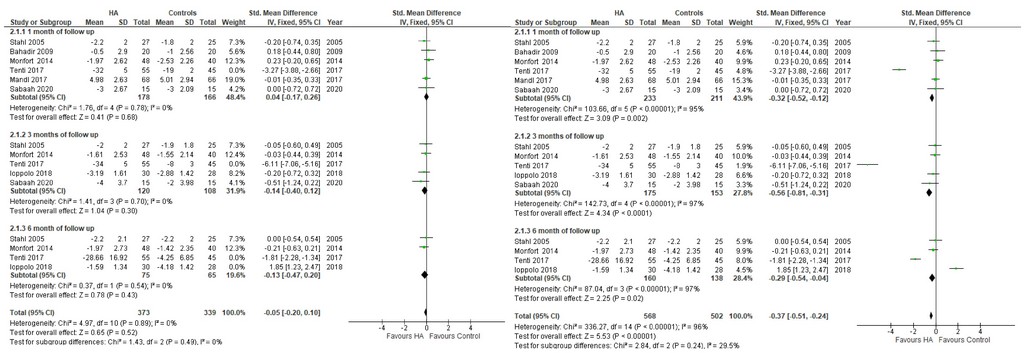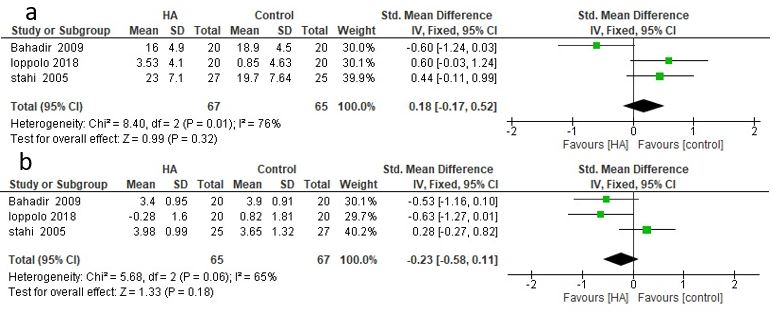Session Information
Session Type: Abstract Session
Session Time: 1:00PM-2:30PM
Background/Purpose: Carpometacarpal osteoarthritis (CMC OA) is a painful condition affecting 21% of hand OA patients. Various treatment modalities have been explored to reduce pain and improve function, including intra-articular injections of hyaluronic acid (HA). However, the effectiveness of HA in managing CMC OA remains a topic of debate.
Methods: We conducted a systematic search across multiple databases, including PubMed, Cochrane Library, Web of Science, and Scopus from inception till February 1st, 2024. We included randomized clinical trials evaluating the efficacy of HA in CMC OA (Figure 1). The main outcome was pain at rest measured by visual analogue scale (VAS). We stratified the outcome into short-term (After 1 month) and medium-term (After 3 months) follow-up and long-term (after 6 months) follow-up. We used Rayyan for identifying duplicates, title, abstract and full-text screening and Review Manager (RevMan) software V.5.3.5 for data analysis.
Results: This systematic review and meta-analysis incorporates data from nine studies, of which seven were included in the main outcome analysis, encompassing a total of 1.070 patients diagnosed with CMC osteoarthritis. The primary objective was to evaluate the efficacy of HA treatment across multiple outcome measures. The VAS for pain relief served as the primary endpoint, demonstrating a significant improvement with HA treatment in short-term (standardized mean difference [SMD] = -0.32, 95% confidence interval [CI]: [-0.52, -0.12]). and medium-term (SMD = -0.56, 95% CI: [-0.81, -0.31]) follow-up and long-term (SMD = -0.29, 95% CI: [-0.54, -0.04]) follow-up than the control groups (figure 2). However, for grip strength, the analysis did not reveal a statistically significant difference (SMD = 0.18, 95% CI: -0.17 to 0.52). Similarly, the tip pinch strength indicated no significant impact of HA treatment (SMD = -0.23, 95% CI: -0.58 to 0.11) (Figure 3).
Conclusion: Intra-articular HA injections provide pain relief in CMC OA, as evidenced by improvements in VAS scores. However, grip strength and tip pinch strength did not show significant differences. Further research and larger randomized controlled trials are warranted to validate these findings.
(b) Forest plot of tip pinch strength. Comparison of intra-articular hyaluronic acid injection vs other interventions in patients with carpometacarpal osteoarthritis. Studies included were loppolo 2018, Bahadir 2009 and Stahl 2005. There was no significant difference in tip pinch strength. CI; confidence interval, df; degrees of freedom, IV; inverse variance, SD; standard deviation.
To cite this abstract in AMA style:
Abdelsalam M, Samy o, al-Najjar A. Efficacy of Intra-Articular Hyaluronic Acid Injection for Nonsurgical Management of Carpometacarpal Osteoarthritis: A Systematic Review and Meta-analysis of Randomized Clinical Trials [abstract]. Arthritis Rheumatol. 2024; 76 (suppl 9). https://acrabstracts.org/abstract/efficacy-of-intra-articular-hyaluronic-acid-injection-for-nonsurgical-management-of-carpometacarpal-osteoarthritis-a-systematic-review-and-meta-analysis-of-randomized-clinical-trials/. Accessed .« Back to ACR Convergence 2024
ACR Meeting Abstracts - https://acrabstracts.org/abstract/efficacy-of-intra-articular-hyaluronic-acid-injection-for-nonsurgical-management-of-carpometacarpal-osteoarthritis-a-systematic-review-and-meta-analysis-of-randomized-clinical-trials/



